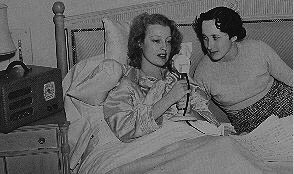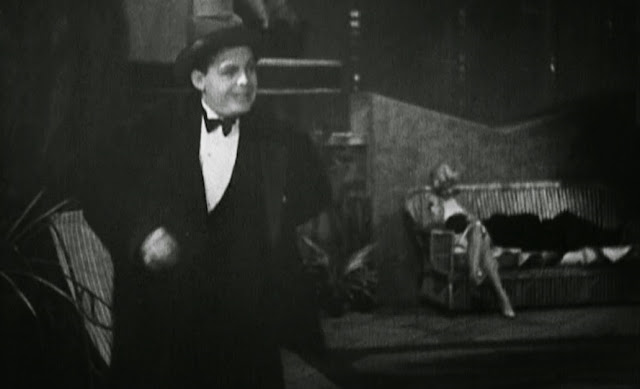Finally (as in three years late!) here is the final installment of my trilogy on the
tragic love story between Jeanette MacDonald and Nelson Eddy and the lengths
MGM boss, Louis B. Mayer went to cover up the adulterous affair. I know, I
know, this is massively late but better late than never, hopefully. Okay, to
catch up read Part 1 then Part 2.
Now, Part 3:
The passing from the 1930's into the 1940's
brought even more heartbreak for the on-again/ off-again couple of Jeanette
MacDonald and Nelson Eddy. Following the success of their first Technicolor
film Sweethearts (1938), the pair
took a break from their film pairings and both moved on to appear in separate
vehicles.
While they were apart and MacDonald was
recuperating from a miscarriage, Eddy, did something that would ruin their
relationship for several years - he married! According to MacEddy.com, Nelson's wedding to Ann Franklin was undertaken under
a haze of drunkenness and blackmail. Apparently, following a night binging with
then friend Franklin, Eddy awoke naked and hungover. Despite having no
recollection of the night's events, Franklin claimed Eddy had made violent love
to her. Confused and wanting to make amends to the distraught Franklin, Eddy
married her in January 1939.
As you can imagine, this came as a massive
shock to the weakened MacDonald who was simultaneously plotting a way to
divorce her husband, Gene Raymond. Depressed, she swallowed a bottle of
sleeping pills only to be saved by director, Woody Van Dyke. The press reported
a "severe cold' was the cause of MacDonald's illness.
It would be the close friendship between
MacDonald and Van Dyke that coerced the actress into her next film with Eddy. New Moon (released mid-1940) brought the
pair together after almost a year apart. Although filming began tense and cold,
the couple rekindled their love towards the end of the shoot. Despite once
again becoming a 'couple' of sorts, they knew there was no chance they could
marry. The trio completed the successful MacDonald/ Eddy/ Van Dyke combination
shortly after with
I Married an Angel (July 1942). To the public it was another MacDonald/ Eddy musical, but the film signaled the end of Eddy's contract with MGM. Having had enough of Louis B. Mayer's control, Eddy bought out his contract and moved to Universal. MacDonald completed one more film with the company and swiftly followed Eddy to Universal. Sadly, the move did nothing to resurrect their popular on-screen pairing with the duo not completing another film together.
I Married an Angel (July 1942). To the public it was another MacDonald/ Eddy musical, but the film signaled the end of Eddy's contract with MGM. Having had enough of Louis B. Mayer's control, Eddy bought out his contract and moved to Universal. MacDonald completed one more film with the company and swiftly followed Eddy to Universal. Sadly, the move did nothing to resurrect their popular on-screen pairing with the duo not completing another film together.
As the decades rolled on, Eddy and MacDonald
performed in the odd radio show together. Despite their continuous bad health,
the pair worked steadily; MacDonald in opera, television and live
performances and Eddy with films, television and a nightclub act. The pair
continued being 'together' but at the same time married to different people.
There was talk of each divorcing their respective spouses and marrying at some point in the late '40s but neither Eddy nor MacDonald could organise deals with their
partners without major financial loss.
Only one event would permanently separate the couple - the death of Jeanette MacDonald. She passed away aged only 61 on January 14,
1965. MacDonald had been suffering heart problems for decades (including at
least two heart attacks in the 1940s) which were being managed until she
required an arterial transplant in 1963. After hearing news of her surgery,
Eddy left his nightclub commitments in Australia and flew to be at her bedside.
She was hospitalised for two months following the surgery. In late 1964 she
back ill again and was rushed to hospital with abdominal adhesions. Strangely
it was Eddy and not Raymond who was with her. She passed away a little over two
months later.
It was Eddy not Raymond who required the most
consolation at McDonald's funeral. He was the last to leave. A radio interview
from Eddy done shortly after her death just broke my heart.
Eddy survived McDonald by only two years. Not
happy years, they were filled with too much drinking and too much work. He died
of a stroke on March 5, 1967 aged just 65.
Something interesting for McDonald/ Eddy lovers
is a video of a 'This is Your Life'
episode dedicated to the career of Jeanette McDonald. Her moments with Eddy are
simply precious.

















